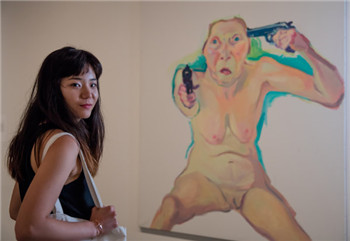(单词翻译:单击)

MARTIN R. ANDERSON, 65, squints to appreciate the geometry of paintings at the museum. Kate Davis, 24, says the sunlight that bounces off museum walls and onto the art can’t be reproduced.
65岁的马丁•R•安德森(Martin R. Anderson)眯着眼睛观赏博物馆中油画的几何构图。24岁的凯特•戴维斯(Kate Davis)说,从博物馆墙壁反射到艺术品上的阳光是不可复制的。
Stan Kaplan, 65, flies across the country just to see a Leonardo da Vinci drawing “more beautiful” than the Mona Lisa. And an elderly woman posts to Facebook a selfie of herself beside a masterwork, presumably commencing an avalanche of social-media approval.
65岁的斯坦•卡普兰(Stan Kaplan)坐飞机穿越整个国家,就为了看一眼列奥纳多•达•芬奇(Leonardo da Vinci)比《蒙娜•丽莎》“还要美”的一幅画。一位年长的女人在Facebook主页上贴出了一张她在一幅大师杰作旁边的自拍,估计会得到社交媒体上的大量点赞。
As for those interviewed, they included students who said museums were like “eating your vegetables” and romantics who cherish their lunch breaks, when they can hop in a cab to go steal a few quiet minutes in front of a beloved painting they have already gazed at dozens of times before.
受访者中有学生,他们说来博物馆就像“吃蔬菜”,还有趁着午休时赶来的浪漫主义者,他们愿意坐出租车赶来,在心爱的油画面前享受安静的几分钟时间,而这些画他们之前其实已经看过几十次了。
A handful of works in particular generated the most comment (a deathbed portrait of an artist’s mistress, a painting of someone being skinned alive) and common themes emerged over time (the ubiquity of technology, people’s short attention spans).
有几幅作品获得了特别多的评价(比如一位艺术家的情妇临终时刻的油画,一幅表现活剥人皮的油画),随着采访进行,有一些共同的主题渐渐开始出现(技巧的普遍性,人们的注意力持续时间之短)。
Here’s what museumgoers said.
下面是一些来博物馆的人说的话。
The artwork: “James Hunter Black Draftee” (1965) by Alice Neel
艺术品:《詹姆斯•亨特黑人新兵》(James Hunter Black Draftee,1965),爱丽丝•尼尔(Alice Neel)
Mr. Anderson’s take: “He probably did get killed because his family would have heard about this painting and said something by now.”
安德森的观点:“他可能已经被杀死了,否则他的家人肯定会听说过这幅画,时至今天,他们会出来说点什么。”
Another perspective: “When I saw this image in the advertisements, I saw it as contemporary, like an album cover.” — Steve Wolkwitz, 25, a student
另一种角度:“当我看到这幅画被用在广告里时,我觉得它是当代艺术,就像唱片封套一样。”——史蒂夫•沃尔克维茨(Steve Wolkwitz),25岁,学生
The artwork: “Self-Portrait With Wig” (1898-1900) by Pablo Picasso
艺术品:《戴假发的自画像》(Self-Portrait With Wig,1898-1900),巴勃罗•毕加索
Ms. Kops’ take: “He was probably drunk.”
科普斯(Ms. Kops)的观点:“他可能喝醉了。”
Another perspective: “I didn’t know it was a Picasso. And then like, whoa. It’s a Picasso.” — Normandie Syken, 20, an illustrator
另一种角度:“我一开始不知道这是毕加索的画,知道了以后才觉得,哇。这是毕加索。”——诺曼迪•西肯(Normandie Syken),20岁,插画家
The artwork: “Untitled I-VI (Green Paintings)” (circa 1986) by Cy Twombly
艺术品:《无标题 I-VI(绿色油画)》(Untitled I-VI [Green Paintings],约1986),赛•通布利(Cy Twombly)
Mr. Meyerhofer’s take: “I want to hate it, but it’s so good.”
梅尔霍夫(Mr. Meyerhofer)的观点:“我本想讨厌它,但它实在太棒了。”
“It’s awful algae green. But you can’t deny it. It grabs you. But part of me thinks it is so crude.”
“它是一种可怕的水藻绿。但是你无法抗拒。它能吸引你的注意力。但是我也觉得它有点粗糙。”
The artwork: “The Flaying of Marsyas” (probably 1570s) by Titian
艺术品:《马斯亚斯的剥皮》(The Flaying of Marsyas,可能是16世纪70年代),提香。
Mr. Meyerhofer’s take: “It’s so violent and awful. My husband would say, ‘I wouldn’t want this on the wall of my living room.’ This must have been the equivalent of a horror movie back in the day.”
梅尔霍夫先生的观点:“它非常暴力,非常吓人。我的丈夫会说,‘我可不想在起居室里挂这么一幅画。’这在当年可能就相当于恐怖片吧。”
Another perspective: “You’re imagining what is he going to do with that knife. The bucket: Is it enough to hold? And his eyes — he can see the pain coming.” — Stan Kaplan, 65, Los Angeles
另一种角度:“你会想像他拿着这把刀要干什么。那个桶,足够用来盛血吗?还有他的眼睛——他可以看到痛苦正在到来。”——斯坦•卡普兰,65岁,洛杉矶
The artwork: “The Vision of Saint John” (1609-14) by El Greco
艺术品:《圣约翰的形象》(The Vision of Saint John,1609-14),埃尔•格列柯(El Greco)
Ms. Campbell’s take: “It could have been a blue sky, but maybe it was going to be dark and stormy.”
坎贝尔女士(Ms. Campbell)的观点:“天本来应该是蓝的,可能会阴沉下去,下起狂风骤雨。”
Another perspective: “It’s so modern. And what’s with these crazy babies floating around?” — William Meyerhofer
另一种观点:“它很现代。这些疯狂的婴儿们飘来飘去是干什么的?”——威廉•梅耶霍夫(William Meyerhofer)
The artwork: “Head of a Woman (La Scapigliata)” (1500-5) by Leonardo da Vinci
艺术品:《女子头像(La Scapigliata)》(Head of a Woman [La Scapigliata],1500-5),列奥纳多•达芬奇
Mr. Miozzo’s take: “This is unfinished, but you can see the psychology of a character. It forces you to think what is in the mind of this young woman. It makes me think, Who was she? What was she thinking?”
米奥佐先生(Mr. Miozzo)的观点:“这幅画没有完成,但是你可以看出人物的心理。它迫使你去思考,这个年轻女人的心里在想什么。它让我去思考,她是谁?她在想什么?”
Another perspective: “I think about how much more beautiful she is than the Mona Lisa.” — Stan Kaplan
另一种角度:“我觉得她比蒙娜•丽莎美多了。”——斯坦•卡普兰
Another perspective: “You need to see this one with your own eyes. No reproduction I’ve seen comes close to this.” — Martin R. Anderson
另一种角度:“你应该亲眼看看这幅画。我见过的复制品都不能与它相比。”——马丁•R•安德森
The artwork: “You or Me” (2005) by Maria Lassnig
艺术品:《你或我》(You or Me, 2005),玛丽亚•拉斯尼戈(Maria Lassnig)
Ms. Choi’s take: “It made me think about women in Korea, where I read that the suicide rate is [very high]. For some reason, I thought about that.”
崔女士(Ms. Choi)的观点:“它让我想起韩国的女人,我读到那里的自杀率(非常高)。出于某些原因,我就是想起这个。”
Another perspective: “This is brave. She’s old. She’s overweight. Think about how courageous this is.” — Michele Miozzo
另一种角度:“这很勇敢。她很老,她很胖。想想这有多么勇敢吧。”——米歇尔•米奥佐(Michele Miozzo)
The artwork: “Cart Full of Action” (1986) by Cady Noland
艺术品:《装满物品的推车》(Cart Full of Action, 1986),卡迪•诺兰(Cady Noland)
Ms. Davis’ take: “I don’t like this. I think the question is not even if it is finished but is this even art? I could see this in a parking lot.”
戴维斯女士的观点:“我不喜欢它。我觉得问题不是它有没有完成,而是它究竟算不算艺术?我在停车场里也能看见这样的东西。”
Another perspective: “This is what the artist is putting into the world. Nothing is a waste of space.” — Tony White, 29, Louisville
另一种角度:“这就是艺术家带给世界的东西。没有什么是对空间的浪费。”——托尼•怀特(Tony White),29岁,路易斯维尔
The artwork: “Gardanne” (1885-86) by Paul Cézanne
艺术品:《贾达尼》(Gardanne, 1885-86),保罗•塞尚(Paul Cézanne)
Michelle Oliveira’s take: “The curious thing to me is why are these unfinished. What better thing did Picasso or Cézanne feel they needed to go and do? Grab a coffee? Go kiss a girl?”
米歇尔•奥利维拉(Michelle Oliveira)的观点:“让我好奇的是,那些作品为什么没能完成。毕加索和塞尚觉得他们最好还是做点别的什么事吗?去喝杯咖啡?去吻一个女孩?”
Nilza Oliveira’s take: “An artist is never finished so their art is never finished. When you finish it, you kill it. Leaving it unfinished, you keep it alive.”
尼尔扎•奥利维拉(Nilza Oliveira)的观点:“艺术家永远不会止步,所以他们的艺术也永远不会完成。一旦完成就是杀死了它,让它保持未完成的状态,就是让它活着。”
The artwork: “Bouquet of Peonies in a Green Jar” (1898) by Paul Cézanne
艺术品:《绿色花瓶中的牡丹花束》(Bouquet of Peonies in a Green Jar,1898),保罗•塞尚
Mr. Scotch’s take: “Those empty spaces could be light. If you put more there, it’s almost too much information. Like this it is allowed to breathe.”
斯科奇先生(Mr. Scotch)的观点:“这些留白应该是光。如果你再添加什么东西,信息就几乎太多了。像这样,就有了呼吸的空间。”
Another perspective: “There are only a few strokes here. But I can tell the petals feel velvet.” — Michele Miozzo
另一种角度:“画上只有寥寥几笔,但我可以感觉到花瓣丝绒般的质感。”——米切尔•米奥佐


